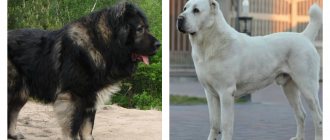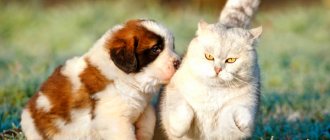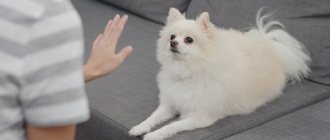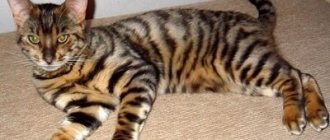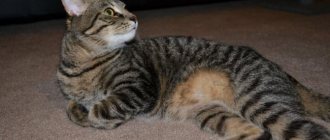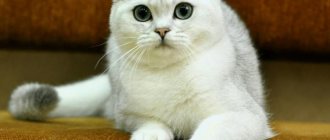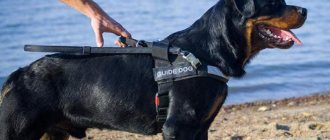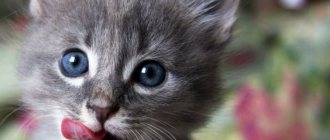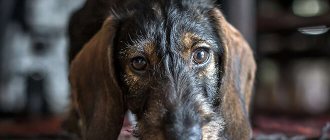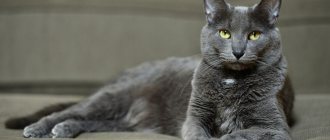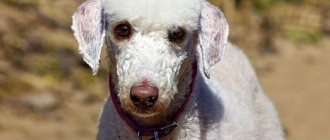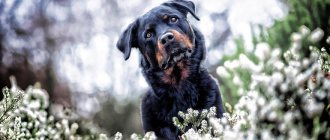History of the breed
The first cat with unusual, curved ears appeared by chance in 1961 in Scotland in the town of Copar Angus. Her name was Susie, and when it was her turn to give birth to offspring, kittens of different sexes appeared with the same unusual feature. The Ross family became interested in the female from the litter and purchased her for breeding purposes. To produce offspring, a fold-eared cat was bred with a British cat, the breed most similar in appearance.
The breed of cats with unusually shaped ears quickly became popular, but after some time it was noticed that many cubs were born with joint pathologies. It turned out that the so-called lop-eared gene, thanks to which animals received an unusual appearance, was a factor contributing to the development of defects. Because of this discovery, the breed was banned from breeding in 1971.
The story of the Scottish Fold could have ended there if not for the research of American scientists. In the course of various experiments, it was found that problem kittens are born only from the union of fold-eared parents. If one of the partners is straight-eared, then the animals will be born absolutely healthy.
This discovery, as well as numerous successful breeding experiences, led to the Scottish breed being recognized by the CFA in 1976. From that moment on, the fold-eared “Scots” received the right to participate in competitions and receive champion titles.
In 1976, Scottish Folds were recognized by the CFA and were given the opportunity to participate in exhibitions
Scottish Folds are not the only cats with fold ears. An in-breed variety of the “Scots” is the Highland Fold - these are animals with the same unusual structure of the ears, but with long fur.
Physical activity
Scottish Folds are exclusively domestic creatures, the peak of activity of which occurs in early childhood, adolescence and adolescence . An adult animal quickly forgets about the follies of youth and wild jumps around the garden beds, focusing its interests on the food bowl and the sofa. Outdoor games, when a “Scotsman” could spend hours chasing a wind-up mouse, are also becoming a thing of the past. Intimate communication with household members comes to the fore, to whom the cat never tires of exposing his sides and back.
Important! Almost all Scottish Folds (especially as they age) are wary of high furniture, perhaps subconsciously feeling that their vestibular apparatus is structured somewhat differently than that of other cats.
And if kittens are still trying to conquer the peaks, then mature animals will definitely not do this, at best gradually jumping from the stool to the table and then to the refrigerator.
The innate passivity characteristic of all Scottish Fold cats does not prevent them from remembering their hunting instincts from time to time. Their patience knows no bounds: cats can track or watch for a victim for hours. Animals in good physical shape climb trees excellently, and when chasing prey, they are able to cover a considerable distance on rough terrain. Despite the fact that Scottish Folds are perfectly adapted to living in confined spaces, it is still recommended to occasionally take them out into the fresh air.
Return to content
Description of Scottish folds
Unusual curled ears, a rounded muzzle, short fur - from this description it’s not difficult to imagine a Scottish Fold cat. A more detailed description is as follows:
- The body is medium in size, slightly elongated, with well-developed muscles, but not massive. Shoulders and hips are the same width.
- The limbs are strong, medium in length and width.
- The tail is medium in size, thick at the base and pointed at the end. Must be sufficiently flexible and mobile.
The tail of these cats is thick at the base and sharp at the end.
- The fur is short, thick, soft and elastic. The color can be any: single-color - white, chocolate, black, cream, blue, lilac, multi-color or striped - tabby, marble, brindle, spotted.
Scottish Folds can be any color
- The muzzle is round, with dense cheeks and pronounced cheekbones. The nose is quite short, without humps or kinks. The chin is quite massive. Widely spaced ears are curved forward and down. The more tightly they are pressed to the head, the more valuable the animal is considered. The eyes are round, large, and widely spaced.
An ideal representative of the Scottish Fold breed - the ears are pressed tightly to the head and fit completely into its circumference, the eyes are large and round, the body is slightly elongated, the fur is plush, and the tail is of medium length
Character
Complaisance, good nature and sociability are the distinctive character traits of the Scottish Fold breed. These animals easily adapt to a new environment and find a common language with all family members, including children. Scottish Folds also get along easily with other pets. They are quite playful, but not hyperactive. Scottish Folds are naturally neat, well-mannered and easy to train. They are quite obedient, affectionate, but without intrusiveness. Scottish Folds prefer to be close to people, but do not like to be constantly bothered.
Scottish Folds will easily find a common language with the whole family
Representatives of this breed are absolutely devoid of aggressiveness. They do not vocalize often, and their meowing is not like usual - it is quiet and a little squeaky.
Some behavioral features of Scottish Folds cannot help but make you smile. For example, these animals look quite funny when they stand on their hind legs, like gophers. Usually they take this position when they want to see something interesting, but out of sight. Their habit of sleeping on their back also looks very cute.
Purchasing a kitten
Choosing a Scottish Fold kitten is not as easy as it seems, because unusual ears are not the only sign that indicates the purity of the breed. The pet must have not only certain appearance characteristics, but also excellent health.
Criterias of choice
A British Fold at the age of 3 months - it is not recommended to take babies younger than this age - already has most of the breed characteristics. The main one is the ears. They should fit snugly to the head and have rounded tips pointing forward. Other breed characteristics of the “Scot” are a rounded head, large round eyes and a short nose.
A rounded head, large eyes and a short nose are the main characteristics of the breed, in addition to the ears.
When meeting a kitten in a nursery, you need to visually verify that there is no underbite or overbite. This is easy to do - just ask to show the cub's teeth - the top and bottom rows should fit perfectly. The body of a small Scottish Fold looks a little elongated, the legs and tail should be quite long.
Special attention must be paid to examining the tail, because its condition is one of the indicators of the health of the Scottish Fold . It should taper evenly from base to end, be flexible and movable, and not have thickenings or creases. If the tail has any defects, there is a high probability that in the near future the animal will develop articular pathology, which is incurable.
Any color of the “Scottish” is allowed, and the fur may not look as luxurious as that of adult individuals, but is still quite thick and soft. Needless to say, a healthy kitten should not sneeze, cough, itch, be apathetic or timid. He should be easy to contact, active and playful. Suspicious discharge from the eyes, dirty ears, a swollen tummy are signs of the presence of some disease.
Documentation of the purchase of a kitten must include a purchase and sale agreement, pedigree and veterinary passport.
“Scottish” kittens are unusually cute - they seem to smile a little
At the moment of birth, all “Scottish” kittens have straight ears; in future folds, they bend after about 3–4 weeks.
Features of care and maintenance
The unpretentiousness of Scottish Folds is one of the main criteria when choosing individuals of this breed as pets. They are easy to care for; your pet's ears and eyes deserve special attention.
Ear and eye care
Due to the unusual structure of the ears, Scottish Folds cannot keep them clean on their own. Their ears should be inspected regularly; cleaning once every three weeks is sufficient, using a cotton swab or a disc without a seam around the edges. It would be useful to use special lotions Ear cleaner, Otifree or similar, as well as Rescuer and Guardian balms. During the cleaning process, you should use a stick in the direction from the base to the tip of the ear. There is no need to penetrate deep inside to avoid injury.
Be careful when cleaning your ears
Scottish Folds have a brachycephalic muzzle, which is why their nasolacrimal ducts are narrower than those of other cats. This can cause your pet's eyes to water frequently. This is completely normal, of course, if the discharge is not excessive and transparent. Eye care involves promptly blotting the discharge with a soft, lint-free cloth or dry cloth. There is no need to rinse them with water - this will lead to disruption of the microflora and subsequent inflammation.
Grooming and bathing
It is enough to brush short-haired “Scots” once a week, and every other day during the shedding period. For this procedure, you should alternately use a comb with sparse, long teeth and a fine brush made of natural bristles or a massage brush with an antistatic coating. If the tail looks good, then it is not recommended to touch it. At the end of the combing process, you should walk through the fur with wet hands to collect the combed hairs.
“Scots” should be bathed as rarely as possible, because this procedure is stressful for the animal and the person. In addition, frequent washing worsens the protective properties of the cat's skin. Instead of taking a bath, you can use dry shampoo or bran heated in the oven. A special product or bran should be rubbed into the pet’s fur and then combed out with a fine brush.
If water procedures are still necessary, then it is better to use a special shampoo to wash the animal. It is better to bathe your pet together, having first spread a towel on the bottom of the bath for stability. The muzzle should be carefully rinsed with water without using shampoo. You need to rinse the fur as thoroughly as possible to completely remove the product used.
Tooth and nail care
To clean your Scottish Fold's teeth, you can use special dry food and chewing toys. Once a week it is recommended to use a special paste and brush. Regular examination by a specialist will help prevent the formation of tartar.
If your cat gets its long claws caught on carpet or clothing, it can get injured. In addition, during the game she may accidentally injure her partner. A nail clipper should be used to trim nails. The procedure has its own nuances - you only need to cut off the transparent part of the claw, without affecting the pink area where the blood vessels are located. An animal needs to have a “manicure” once every 14 days up to six months of age and once every thirty days for adults.
You need to trim your cat's claws carefully, without touching the sensitive pink area.
Nutrition
The diet of Scottish cats must be balanced and consist of high-quality products. By using ready-made premium food to feed your animal, you can be sure that your pet gets everything it needs. Those owners who choose natural products for their cats should know about the principles of proper nutrition:
- The basis of the diet of “Scots”, however, like all cats, should be meat - boiled or raw, but frozen. It should be boneless and lean - poultry or beef will do.
Meat is the basis of any cat’s diet.
- A portion of meat food for “Scots” is usually enriched with plant foods - cabbage, carrots, pumpkin, parsley or bran.
- Pre-boiled offal is also used to feed Scottish Folds. Pets should be given fish no more than once a week - only sea fish, boned and boiled.
- The diet should also include low-fat fermented milk products and porridges - buckwheat, rice, oatmeal.
- Experts recommend including calcium or seaweed supplements in the Scots’ diet.
- The animal also needs to eat grass - it contains useful elements and helps remove lumps of fur from the stomach that form when cats lick their fur.
The feeding frequency of individuals up to one and a half years old is from 3 to 5 times a day. Older animals can be fed no more than 3 times a day. Your pet should always have water in his bowl.
You can feed Scottish cats either natural food or ready-made premium store-bought food.
Scottishfold care
By their nature, Scots are unpretentious in grooming: it is enough to brush short-haired cats once a week, and 2-3 times for long-haired cats. Bathing often is not recommended at all, but their character helps them cope and easily endure even such a stressful situation for many cats.
But you should always keep an eye on the cleanliness of your ears: due to their unusual shape, earwax can accumulate, which needs to be cleaned regularly and carefully.
Interesting information about the representatives of the breed
- The breed is not yet recognized in its homeland in Scotland. And, the funny thing is, it’s because of the ears.
- Most Scots are shorthaired.
- Babies' ears do not curl immediately - they are born with straight ears, which begin to curl only at 3-4 months. Those representatives of the species whose ears are not bent are called Scottish Straight (straight-eared, respectively).
- They can stand on their hind legs for a long time.
- Males are usually larger than females.
- If you cross Scots with each other, the offspring may have serious problems with the ears. Therefore, they are bred with ordinary non-fold-eared cats.
- Although most Scottish Folds are chronic couch potatoes, when choosing a pet, a more active one will be distinguished by its mobility compared to other kids.
The peacefulness and easy, affectionate nature of the cat are the undoubted advantages of the breed. And speaking about character flaws, you understand that they are not so great or critical. There are animals that require much more attention and are more demanding to care for, and their character is completely different.
He will relieve stress after a hard day at work, become a faithful friend who will love his owner and will always be faithful to him, without causing difficulties or inconvenience. The main thing is not to forget to feed him, because sometimes you may not hear how the fluffy one asks to eat, provide proper care and show your love and affection - then there will definitely not be any problems with your pet and its character.
Let your new family member feel comfortable in your home, then you will not be deprived of his attention. https://www.youtube.com/embed/cnAk9xkuCls
Diseases common to Scottish Fold cats
Scottish cats cannot be called unnecessarily sickly. The presence of a predisposition to certain pathologies does not mean that they will necessarily manifest themselves. By purchasing kittens from responsible, trusted breeders, not forgetting about regular visits to the veterinarian, and carrying out timely vaccinations and deworming, you can reduce the risk of developing most serious diseases. The following are the pathologies that can most often be observed in “Scots”, some of which are characteristic of this breed, while others are found in any animal of the cat family:
- Osteochondrodysplasia. A hereditary malformation of bone and cartilage caused by the presence of the so-called lop ear gene. It is expressed by deformation of the limbs, lameness, and slow growth. The tail of such animals is short and inactive. The pet has difficulty jumping on and off. The pathology cannot be cured. The cat is prescribed only supportive therapy, including anti-inflammatory drugs and chondroprotectors.
- Cardiomyopathy. Heart disease, symptoms of which include heavy breathing, shortness of breath, lethargy, and cough. In addition to the therapy prescribed by a specialist, the owner must protect the animal from stressful situations, and also ensure that a supplement containing taurine is present in the pet’s diet.
- Urolithiasis disease. Manifestations of the disease are frequent and painful urination, the presence of blood in the discharge. It is much more common in cats than in cats. If symptoms are detected, you should immediately contact a specialist. Before being examined by a veterinarian, you can alleviate your pet's condition by using a warm heating pad, which should be placed on his stomach.
- Tearing. Due to the special structure of their muzzle, “Scots” are prone to excessive discharge from the eyes. If they are transparent, then there is no need to panic. You just need to adhere to the rules of hygiene. If there is any change in the color of the secreted fluid, you should consult a doctor.
- Obesity. The Scots' tendency to be overweight is not a death sentence. The owner's adherence to the principles of proper nutrition will help keep the pet's weight normal.
Obesity can be avoided if you feed and play with your pet properly.
- Ringworm. A pet owner of any breed can face this problem. If characteristic spots on the skin and fur loss are detected, it is necessary to immediately begin treatment and protect all household members from contact with the animal. Treatment of the disease includes the use of ointments Clotrimazole, Miconazole, injections with Vakderm or Microderm. It is important to wear gloves when treating an infected animal.
- Ear problems. Common ear diseases include otitis media, an inflammation caused by various causes, and otodecosis, which is infestation with ear mites. If your pet scratches and curls up its ears, shakes its head, or there is discharge from the ears, you should immediately contact a specialist.
An experimental treatment for osteochondrodysplasia is irradiation. Radiation therapy relieves pain and prevents further development of pathology. This treatment is practiced only in Europe; Russian clinics lack the necessary equipment.
Breeding
Mating cats and Scottish Fold cats has its own characteristics. Compliance with the rules is the key to a successful result. Scottish Folds reach sexual maturity at the age of 9–10 months, but it is better to breed a cat no earlier than one and a half years. It is then that the female is ready for pregnancy and childbirth.
It is impossible for both the cat and the cat involved in mating to have the gene for lop-earedness. Scottish Folds should only be bred with Scottish Straights. Otherwise, the offspring may not be viable or have serious pathologies. It is also not allowed to breed a Scottish breed with a British one - the consequences can be unpredictable.
In a pair, only one animal can be fold-eared
To improve the breed qualities of a partner’s animals, it is better to choose the same or similar color.
It is advisable that the male be experienced, especially if this is the first mating for the cat. Usually the “date” takes place in the cat’s territory. The female is brought to the male on the second day of estrus. Mating lasts two to three days.
Cat or cat
The character of many animals (and the “Scots” are no exception) depends on their gender. Cats are more self-sufficient and seem to be condescending towards their owner, perceiving him as a useful object that satisfies the cat’s whims.
At the same time, males are more assertive and inquisitive than females. Males scour the house in search of adventures and, what is most sad for the owner, they often find them scratching furniture, breaking vases, artistically tearing apart sofa upholstery. During puberty, they turn into real monsters, leaving odorous marks in all accessible places.
Important! In addition, during the rut, even the shyest cats often lose their fear and attack their household members, biting and scratching their legs. The only salvation here can be castration (if you do not plan to breed your pet with pedigree cats). To be fair, we note that anxious females in estrus are equally unbearable, so they also need sterilization to calm down.
On the other hand, the Scottish Fold cat (against the cat) is more attached to a person and is not afraid to show her love openly . She is more interested in constant human attention, which is why she is ready to fight for his sympathy tirelessly and tirelessly.
Return to content
Castration and sterilization
There comes a time in the life of every cute pet when the animal enters puberty. Loud meowing, a sharp, specific smell when the cat begins to mark its territory, and other unpleasant moments complicate the life of both the pet and the household members living with it. To solve the problem, many owners resort to sterilization or castration. Both of these operations, differing in technique, disrupt the reproductive function of the animal.
The most popular procedure is castration - it is easy to perform and less expensive, and is indicated for both cats and females. You should resort to it no earlier than 10 months of age - earlier operation can lead to disruption of the animal’s physical development. Castration solves two problems at once - it eliminates unpleasant manifestations associated with the animal’s sexual life and eliminates the appearance of unwanted offspring.
The operation is completely safe and does not take much time - no more than 15 minutes. The pet quickly returns to normal life, becomes calmer and more affectionate.
Features of postoperative care
Caring for your pet after castration is easy. You can take the animal home on the day of surgery. Upon arrival, you should first stay close to your pet - make sure that it does not become hypothermic and lies on its side all the time. Until the cat wakes up from anesthesia, you should not place it on a bed or sofa - the animal does not control its movements and may fall.
There are modern operating techniques that do not involve suturing, even when operating on a cat. The animal's wounds heal very quickly, you just need to make sure that no dirt gets into them, and also lubricate them with brilliant green.
How to care for a Scottish Fold kitten
In the first days, newborn kittens do not separate from their mother; they are completely helpless. And only on the 10th day they begin to crawl and get acquainted with the world. An experienced breeder helps little kittens be born.
Up to two months, the main food for babies is mother's milk. Boiled meat, milk porridge, and yolk should be carefully introduced into the diet. Scottish Fold kittens are then cared for by their foster families.
Small cats love goat or cow's milk, milk porridge, cottage cheese, and vegetable purees. By six months, plush kittens switch to the adult menu. Monitor the condition of the cubs' ears, eyes and fur.
The Scottish Fold kitten is very smart and easily accustoms itself to daily procedures by its owner. The eyes may run, put drops in and wipe with a special lotion.
To ensure that your kitten feels comfortable in your home from the first days, get something from the breeder with a familiar smell. This could be a bedding, a toy, a handful of filler.
